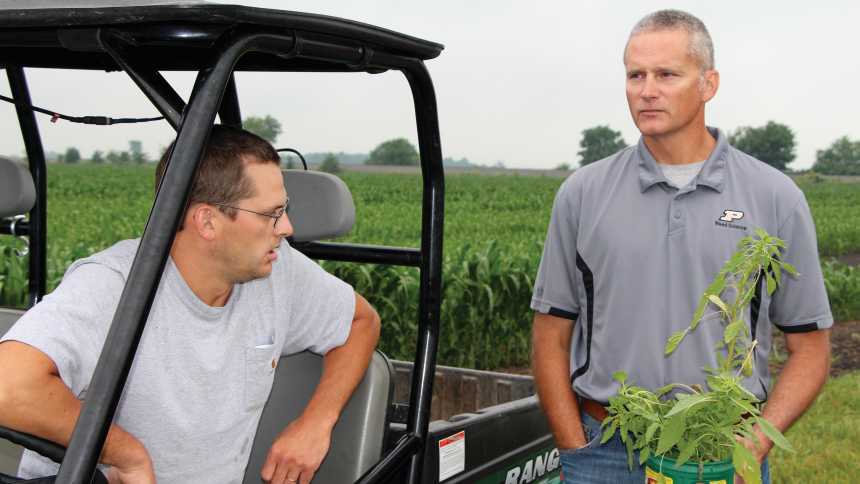Herbicides 2015: A New Hope

Purdue University weed scientist Dr. Bill Johnson (right) holds a freshly harvested pigweed plant in a Kankakee, IL-area plot where the university conducts research evaluations of various herbicide active ingredients.
Throughout the Midwest herbicide resistant weeds are infiltrating fields like Luke Skywalker and his fleet of X-Wing fighters when they heroically took down the Death Star in “Star Wars Episode IV: A New Hope.”
That iconic bit of sci-fi cinema notwithstanding, our annual CropLife 100 survey, a moment-in-time snapshot of the industry from the ag retailer point of view, confirms such, with 41% of those polled (81 responses) indicating herbicide-resistant weeds were “a problem in many fields” during 2014.
In the central Illinois area, where glyphosate-resistant Palmer amaranth is still relatively new but becoming more established with each passing season, growers and Extension specialists alike are still wrapping their heads around just how widespread the problem is becoming.

Aaron Hager, University of Illinois-Champaign Extension
“Unfortunately, we really don’t know how widespread the glyphosate-resistance problem in Palmer is yet,” says Aaron Hager, Extension specialist/weed scientist, University of Illinois-Champaign Extension. “What we do know is that the weeds we’ve identified as Palmer were additionally tested with a different set of genetic markers and well over 50% of those turned out to be confirmed glyphosate resistant.”
As these troublesome (and often quite costly) weeds continue to grab up, acreage in their iron grasp across new geographies, its important growers (and their retail agronomist partners alike) are always re-evaluating their weed control strategies.
“What we’ve encouraged people to do when they find populations of Palmer is don’t necessarily assume glyphosate will effectively control it,” advises Hager. “Don’t forgo a more integrated system just thinking that all you need to do is spray it one time with a glyphosate-containing product and that’s going to remove the population, because it might not.”
Additionally, in a recent press release Hager explained that the University of Illinois-Extension weed science program no longer recommends fall application of residual herbicides to control Amaranthus species the next spring for the following reasons:
- Inconsistent performance. Performance consistency of soil-residual herbicides applied in the fall is greatly dependent on weather and soil conditions after application. U of I data suggest the greatest and most consistent control of Amaranthus species either at planting or several weeks after planting was achieved when residual herbicides were applied in the spring, not in the fall.
- Increased selection for herbicide-resistant biotypes. Soil-applied herbicides are not immune from selection for herbicide-resistant biotypes. Following a fall application, the concentration of herbicide remaining in the spring when Amaranthus species begin to germinate will be much lower compared with the same product rate applied closer to planting.
“Applying a soil-residual herbicide late in the fall in hopes of having a clean field prior to planting is akin to gambling on the weather,” Hager said. “Cold winter conditions (similar to last winter) can reduce herbicide degradation in the soil and increase herbicide persistence.
“This might not always be favorable since, depending on the residual herbicide, increased persistence also can cause injury to the following crop. A more-moderate winter and early spring warming will increase herbicide degradation, which could result in the need for a burndown herbicide to control existing vegetation before planting.”
Spray Market A Bear
While the spread of herbicide resistance is surely a sore subject for the grower, in many situations retailers are seeing increased business opportunities due to the issue. According to the CropLife 100 survey, crop protection products, up 8% in 2013, gained another 9% of the crop protection product market share in 2014, reaching a total value of $9.3 billion among the retail organizations polled. An additional 75% of respondents characterized herbicide sales for 2014 as up, with only 13% reporting flat revenue.
Manufacturers are taking note with many in the process of launching formulations that address the weed resistance crisis via new actives.
Dow AgroScience’s Enlist Duo herbicide, a proprietary blend of glyphosate and 2,4-D choline, is all zipped up and ready to go for the 2015 season after what feels like a lifetime in anticipation of its release.
The herbicide, launching in conjunction with what Dow calls “a stewarded introduction” of Enlist corn and seed production of Enlist soybeans in 2015, claims reductions in volatility and off-target movement, improved handling characteristics and reduced odor compared with previous 2,4-D formulations.
“Enlist Duo will set a new standard in the marketplace for herbicides,” says Damon Palmer, marketing director, Dow AgroSciences’ U.S. Seeds Business. “We have made significant investments in existing and new assets to reliably supply high quality 2,4-D choline for Enlist Duo, and we are ready to meet market demand.”
More New Modes Of Action
Syngenta, with its much-anticipated Acuron herbicide (bicyclopyrone, atrazine, mesotrione and S-metolachlor), is another outfit debuting a herbicide in 2015.
Acuron, nearing commercialization after five years in development, is looking to become the first new herbicide registered for giant ragweed in quite some time, according to Gordon Vail, technical product lead.
“This next HPPD inhibitor is a product that I’m very excited about — it has really shined on morning glory and has shown a nice four- to six-week residual,” Vail said during his presentation at the 2014 Syngenta Media Summit.
For their part, retailers can expect to hear from Syngenta in the coming months as the company reaches out at the dealership level to make sure application is stewarded properly.
“We’ll put together a sheet that breaks down tank clean out and all of the possible tank mixes and get that out ahead of the product,” said Vail. “January and February we’ll be doing some large scale field tests; so far all of the tank mixes look really good, but until you do large scale commercial trials you won’t really know.”
Valent U.S.A is also launching a new residual, broad spectrum herbicide in the coming months. Fierce XLT soybean herbicide will be sold in a straight goods package as a mixture of Fierce and Valor XLT for the 2015 season.
Fierce XLT claims effective activity on glyphosate-resistant Palmer amaranth, waterhemp, giant ragweed and marestail, as well as some of the small seed broadleafs like lambsquarter.
Valent is stewarding application of Fierce as a two to three pass system. “This product provides some of the cleanest pre-emerge plots I’ve seen,” says Eric Ott, Valent U.S.A. field market development specialist. “Still, we wouldn’t expect a pre-emergence application to control the weeds all season, hence recommending it as a two to three pass system.”
According to Ott, Fierce XLT received high marks in several small plot evaluations from Extension specialists at Michigan State University, Purdue University and the University of Illinois-Champaign, registering a nine rating for waterhemp control on the zero to 10 scale used for quantifying activity levels on different weed species.
Fierce XLT garnered EPA approval back in September and is all set for 2015 season deployment.
Bayer CropScience is pushing its Capreno, a post-emergence, one pass weed control product for resistant broad leaf weeds and grasses, for 2015.
Capreno features two modes of action — HPPD and ALS inhibitors — to achieve long lasting residual activity in corn throughout the V5 growth stage. The product typically carries a 3 ounes per acre use rate, although when tank mixed with Liberty herbicide (formerly Ignite) only 2 ounces per acre of Capreno is required.
DuPont Crop Protection has a twofold focus in herbicides for the coming season with Afforia (corn, soybean and wheat) and Trivence (soybeans).
Both featuring multiple modes of action (Afforia 2, Trivence 3), the herbicides are being presented as residual control solutions for herbicide-resistant weeds, according to James Hay, business director, North America.
“Trivence is particularly valuable to soybean growers facing glyphosate- and ALS-resistant weeds,” he says. “And Afforia offers multiple production benefits to help growers get a head start on spring weed control. An early start is critical to preventing the spread of resistant weed biotypes and encouraging uniform emergence and strong stand establishment.”






